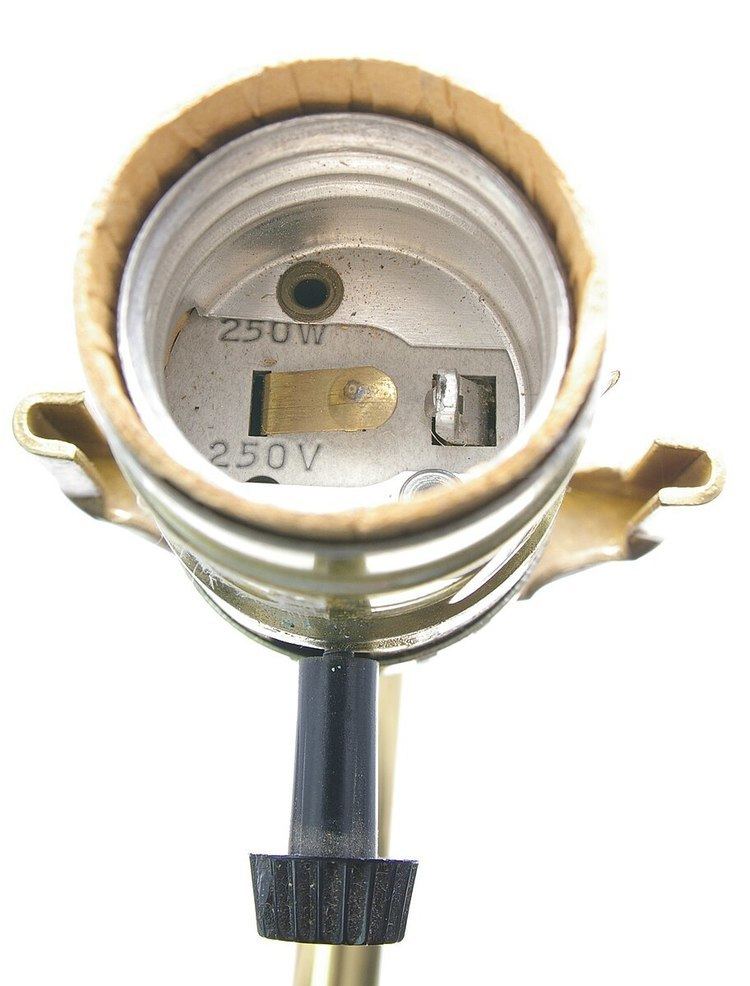 | ||
Lightbulb sockets, lamp sockets or lampholders provide electrical connections to the lamps and support it in the lighting fixture. The use of sockets allows lamps to be safely and conveniently replaced (re-lamping). There are many different standards for these lampholders, created by de facto and by various standards bodies. A general coding system is a letter or abbreviation followed by a number. Some miniature lamps have wire leads suitable for direct connection to wires; some reflector lamps have screw terminals for wire connections.
Contents
- Construction and materials
- Edison screw bases
- Bayonet styles
- Bi post
- Bi pin connector
- Wedge base
- Fluorescent tubular lamp standards
- Lamp base styles
- References
The most common type of sockets for mains electricity are Edison screws, used in continental Europe and the United States, while bayonet mounts dominate in the Commonwealth countries and in the automotive industry. Fluorescent lamps require a different, typically four-pin design. A broad variety of other socket designs exists, applied for specialized lamp constructions.
Construction and materials
The construction of a lampholder socket defines and limits its intended use. Ceramic insulation can withstand considerably higher operating temperatures than bakelite or other plastics. The electrical components and wires must be designed to carry the intended current plus a safety factor.
The contact surface area, thickness and conductivity of the metal, connection methods and maximum operating temperature must all be considered in the design of a new socket. In addition, mechanical factors such as shape of the socket, fixture mounting and attachment, lamp support, ease of re-lamping and total cost of manufacture must be considered. Sockets designed for ordinary household and industrial use have much more design leeway than those used in precision applications.
The lampholder must be located far enough from the filament that the metals with the lowest melting point will remain solid. Historically this metal was a tin/lead solder whose melting point might be as low as 180 °C (360 °F). Due to the thermal changes from ambient temperature to full operating temperature, the design of a socket must allow for a considerable amount of expansion and contraction. Spring elements are required to accommodate these dimensional changes. However - the temperature at which a metal loses its spring is far below the melting point. This is why some older sockets that no longer work can be restored by prying up the base spring slightly.
Lampholder failures are usually caused by mechanical abuse or by overheating. A socket with a built-in switch is far more likely to fail in normal use as the switch parts wear out. Insulation failures are usually caused by impacts or by difficulty inserting or removing a lamp. Sockets used outdoors or in damp areas often suffer from corrosion which can cause the lamp to "stick" in the socket and attempts to change a lamp can result in breakage of either the lamp or the lampholder. The corrosion is not only environmentally produced but may be a result of the current flowing through the parts when there is appreciable resistance between the parts. Fixtures in such environments may require gaskets or other waterproofing methods to prevent buildup of moisture in the socket area.
Edison screw bases
The light bulb commonly used since the early 20th century for general-purpose lighting applications, with a pear-like shape and an Edison screw base, is referred to as an "A-series light bulb."
Bayonet styles
Bi-post
With bi-post bases, lamp orientation is fixed so filament will always be in the focal plane. Filament configurations such as the C13D (coiled, zig-zagged) emit far more light perpendicular to the zig-zag than parallel to it.
Common types:
Bi-pin connector
The 2 pin socket is an update of the bi-post design with smaller pins designed to reduce the cost of manufacture. The 1000 watt FEL medium 2 pin base halogen lamp allows designers to insert the lamp into the end of the ellipsoidal reflector through a smaller hole than previously possible with conventional incandescent lamps. This improves efficiency compared to the older side inserted lamp or a double ended lamp which requires two holes. One variation is the Polarized 2 pin socket - used primarily in projectors, which defines the exact positioning of the filament on one side. This improves the "point source" characteristic necessary for building complex optical systems.
Another facet of the two pin design is that many new designs of lamps use baseless glass envelopes. The wire leads are thickened and crimped in the glass envelope of the lamp base. The MR16 is an example of this design. You may argue that the reflector itself is the base, but the industry has decided that the reflector is an assembly where the actual lamp is inserted into the reflector with the leads sticking out and a ceramic paste used to glue it in.
Wedge base
Miniature lamps may have a wedge base made of glass or plastic.
Fluorescent tubular lamp standards
Lamp base styles
Some of the above base styles are now obsolete. The trend in recent years has been to design newer bases to reduce waste of raw materials and simplify the replacement process.
